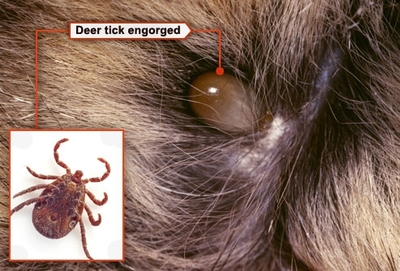What to feed a dog with Lyme disease? Providing the right nutrition is crucial when it comes to managing your furry friend’s health condition. Lyme disease, a tick-borne illness that affects dogs, can cause a range of symptoms, including lethargy, loss of appetite, and muscle soreness. While a proper diet cannot cure the disease, it can help support your dog’s immune system and overall well-being. In this article, we’ll explore the dietary considerations for dogs with Lyme disease and the types of food that can be beneficial for their recovery. Let’s delve into the topic and find out what your furry companion needs for a balanced and nourishing meal.
**
Table of Contents
The Importance of a Proper Diet for Dogs with Lyme Disease
**

Source assisianimalhealth.com
Just like humans, dogs can also be affected by Lyme disease, a bacterial infection transmitted through tick bites. When a dog is diagnosed with Lyme disease, it is crucial to provide them with the necessary care and attention, including a proper diet. A balanced and nutritious diet can help support their immune system and aid in their recovery. In this section, we will discuss the importance of a proper diet for dogs with Lyme disease and offer some valuable insights on what to feed them.
1. **The Role of Diet in Lyme Disease Management**
A dog’s diet plays a crucial role in managing Lyme disease. Providing a well-balanced diet can help bolster their immune system, promote overall health, and aid in their recovery process. A nutrient-rich diet will strengthen their body’s natural defense mechanisms, allowing them to combat the infection effectively.
2. **Consult with a Veterinarian**
Before making any changes to your dog’s diet, it is essential to consult with a veterinarian. Every dog is unique, and their dietary needs may vary based on their age, size, and overall health condition. A veterinarian can provide tailored advice on what specific dietary adjustments may be needed to support your dog’s immune system and overall wellbeing.
3. **Focus on Quality Proteins**
Proteins are essential for dogs as they aid in tissue repair and muscle maintenance. When dealing with Lyme disease, it is particularly important to provide your dog with high-quality proteins. Consider incorporating lean meats like chicken, turkey, or fish into their diet. These proteins are not only nutritious but also easier to digest and absorb.
4. **Include Omega-3 Fatty Acids**
Omega-3 fatty acids have numerous health benefits for dogs, including reducing inflammation, supporting a healthy coat and skin, and promoting cardiovascular health. Incorporate sources of Omega-3 fatty acids into your dog’s diet, such as fish oil or flaxseed oil. These supplements can be added to their meals or as directed by your veterinarian.
5. **Complex Carbohydrates for Sustained Energy**
Complex carbohydrates provide a steady release of energy and are an essential component of a well-rounded diet. Include carbohydrates like whole grains and vegetables in your dog’s meals. These nutrients will help fuel their daily activities and maintain their energy levels.
6. **Antioxidant-Rich Foods**
Antioxidants play a crucial role in supporting a dog’s immune system. Including antioxidant-rich foods in your dog’s diet can help fight off the free radicals produced during the infection. Blueberries, spinach, sweet potatoes, and carrots are excellent sources of antioxidants that can be incorporated into their meals.
7. **Probiotics for Gut Health**
Lyme disease and its treatment may disrupt your dog’s gut health. Including probiotics in their diet can help restore a healthy balance of gut bacteria. Yogurt or specialized probiotic supplements formulated for dogs can be added to their meals to support their gastrointestinal health.
8. **Hydration is Key**
Ensuring your dog remains adequately hydrated is vital, especially during their recovery from Lyme disease. Make sure your dog has access to clean water at all times and encourage them to drink regularly. Hydration supports their overall health, aids in digestion, and helps flush out toxins.
9. **Avoid Potential Food Triggers**
Some foods may have inflammatory effects or allergies on certain dogs. While managing Lyme disease, it is essential to avoid potential food triggers that may hinder the healing process. Common allergens for dogs include grains, dairy products, and certain proteins. Monitor your dog’s reactions to specific foods and consult with your veterinarian if necessary.
10. **Monitor Weight and Adjust Portions**
While your dog is recovering from Lyme disease, it is crucial to monitor their weight and adjust their feeding portions accordingly. Dogs may experience changes in appetite or fluctuations in weight during the disease. Consult with your veterinarian for guidance on maintaining an appropriate weight and adjusting their diet as needed.
By providing a well-balanced diet, rich in essential nutrients, you can support your dog’s immune system, aid in their recovery, and promote overall wellness while dealing with Lyme disease. Remember that each dog is unique, so it is important to consult with a veterinarian for personalized dietary recommendations. With proper care and nutrition, your furry friend can overcome Lyme disease and regain their vitality.
What to Feed a Dog with Lyme Disease
Lyme disease is a tick-borne illness that can affect dogs, causing symptoms like fever, lethargy, joint pain, and loss of appetite. While specific medications are prescribed by veterinarians to treat Lyme disease, a proper diet can also play a crucial role in supporting the dog’s recovery and overall well-being. In this section, we will discuss ten essential subtopics related to feeding dogs with Lyme disease.
1. Balanced and Nutritious Meals
To ensure a healthy and speedy recovery, it is crucial to feed your dog balanced and nutritious meals. A diet rich in essential nutrients, vitamins, minerals, and antioxidants is necessary to support the immune system and aid in combating the infection.
A well-balanced meal should include high-quality protein sources, such as lean meats like chicken or turkey, which provide essential amino acids for tissue repair. Additionally, include complex carbohydrates like brown rice or sweet potatoes, offering a good source of energy while being gentle on the digestive system.
2. Omega-3 Fatty Acids
Omega-3 fatty acids, commonly found in fish oil supplements or fatty fish like salmon, have powerful anti-inflammatory properties. Adding these fats to your dog’s diet can help reduce the inflammation associated with Lyme disease and promote joint health. Consider discussing the appropriate dosage with your veterinarian.
3. Antioxidant-Rich Foods
Incorporating antioxidant-rich foods into your dog’s meals can aid in neutralizing the damaging effects of free radicals and support the immune system. Blueberries, spinach, carrots, and pumpkin are excellent sources of antioxidants and can be added to your dog’s diet in moderation.
4. Probiotics for Gut Health
Lyme disease and its treatments can disrupt the natural balance of gut bacteria in dogs. Including probiotics in your dog’s diet, such as yogurt or specialized supplements, can help restore and maintain a healthy gut flora, aiding in digestion and nutrient absorption.
5. Adequate Hydration
Proper hydration is essential for dogs with Lyme disease. Ensure your furry friend has constant access to fresh, clean water. Encourage drinking by placing additional water bowls throughout the house and keeping them easily accessible.
6. Calorie Management
Weight management is crucial, especially for dogs experiencing reduced activity levels due to Lyme disease. Work closely with your veterinarian to determine the appropriate daily calorie intake for your dog, adjusting it as needed to help maintain a healthy weight.
7. Natural Supplements
Supplements such as glucosamine and chondroitin sulfate can benefit dogs with Lyme disease. These natural supplements promote joint health and help maintain cartilage integrity, potentially reducing the discomfort caused by Lyme-related joint inflammation.
8. Fresh, Wholesome Treats
When it comes to treats, opt for fresh and wholesome options, avoiding those high in preservatives, artificial colors, and flavors. Treats can be used as rewards during training sessions or simply as a small gesture of love, but always in moderation.
9. Consultation with a Veterinary Nutritionist
If you have concerns about your dog’s diet during Lyme disease, consider seeking the advice of a veterinary nutritionist. These professionals can create a customized meal plan based on your dog’s specific needs and requirements, helping accelerate their recovery.
10. Monitor and Adjust
Always monitor your dog’s body condition, appetite, and behavior. Lyme disease affects dogs differently, and each individual may have unique dietary needs. Regularly communicate with your veterinarian, who can guide you on making any necessary adjustments to your dog’s diet plan.
In conclusion, providing a nutrient-rich, well-balanced diet to your dog with Lyme disease can support their recovery and overall health. Along with medications prescribed by your veterinarian, addressing their dietary needs will ensure they receive the essential nutrients to combat the infection and promote a speedy recovery. Remember, consistency and regular communication with your veterinarian are key to tailoring the diet to your dog’s specific needs.
1. High-Quality Protein
When it comes to feeding a dog with Lyme disease, providing a diet rich in high-quality protein is essential. Protein is responsible for repairing and building tissues, promoting immune function, and supporting overall well-being. Opt for lean sources of protein such as chicken, turkey, fish, or lean cuts of beef. These protein sources not only provide essential amino acids but also contain less fat, making them suitable for dogs that may have decreased activity levels due to Lyme disease.
In addition to lean meats, consider incorporating protein-rich plant-based foods into your dog’s diet. Lentils, quinoa, and soybeans are excellent options that provide the necessary amino acids without compromising your dog’s digestive health.
2. Omega-3 Fatty Acids
Omega-3 fatty acids have several health benefits for dogs, including reducing inflammation and supporting joint health. These fatty acids are particularly important for dogs with Lyme disease as the disease can cause joint stiffness and discomfort. Incorporating foods rich in omega-3 fatty acids can help alleviate these symptoms.
Fish oil supplements are a convenient way to ensure your dog is getting an adequate amount of omega-3 fatty acids. Alternatively, you can introduce oily fish such as salmon or sardines into their diet. Remember to remove any bones and cook the fish thoroughly before feeding it to your dog.
3. Antioxidant-Rich Foods
Incorporating antioxidant-rich foods into your dog’s diet can help boost their immune system and reduce oxidative stress caused by Lyme disease. Fruits and vegetables such as blueberries, spinach, sweet potatoes, and carrots are excellent sources of antioxidants.
Consider creating a homemade dog food recipe that includes these antioxidant-rich ingredients. You can mix them with lean meats or plant-based proteins to provide a balanced meal. Alternatively, you can include them as healthy, low-calorie treats throughout the day.
4. Probiotics and Digestive Support
Since Lyme disease can disrupt the digestive system, it is crucial to provide your dog with probiotics and digestive support. Probiotics help maintain a healthy balance of gut bacteria, which can enhance digestion and boost immune function.
You can find probiotic supplements specifically formulated for dogs at your local pet store or incorporate natural probiotic sources into their diet. Plain yogurt or kefir (a fermented milk drink), for example, can introduce beneficial bacteria into their system. Be sure to check for any lactose intolerance or allergies before introducing dairy products.
5. Adequate Hydration
Ensuring your dog stays hydrated is vital for their overall health, especially when dealing with Lyme disease. Consuming enough water helps flush out toxins and supports proper organ function.
Keep fresh water available for your dog at all times. You can add flavor to their water by introducing low-sodium bone broth, which can be appealing for dogs with decreased appetite due to the disease. Consider using a pet fountain or placing multiple water bowls around the house to encourage frequent drinking.
| Recommended Foods | Restricted Foods |
|---|---|
| Lean meats (chicken, turkey, fish) | Fatty cuts of meat |
| Lentils, quinoa, soybeans | Processed or fried foods |
| Blueberries, spinach, sweet potatoes, carrots | High-sugar treats or snacks |
| Fish oil supplements, salmon, sardines | Raw or undercooked fish |
| Plain yogurt, kefir | Dairy products if intolerant |
Conclusion: What to Feed a Dog with Lyme Disease
We hope that this article has provided you with valuable information on what to feed a dog with Lyme disease. Remember, a balanced diet rich in nutrients and antioxidants can help strengthen your furry friend’s immune system and aid in their recovery. As you embark on this healing journey together, don’t forget to consult with your veterinarian for personalized advice and guidance. Thank you for taking the time to read our article, and we encourage you to visit again for more useful tips and information on how to keep your furry companion healthy and happy. In the meantime, feel free to explore our website and discover other articles that could further enhance your pet’s well-being. Wishing you and your beloved dog a speedy recovery and many wonderful moments together!
 Treat For Dog – Brain Training for Dogs, Dog Training & Obedience Discover Treat For Dog and get your pup on the path to smarter, happier, and healthier living with brain training for dogs.
Treat For Dog – Brain Training for Dogs, Dog Training & Obedience Discover Treat For Dog and get your pup on the path to smarter, happier, and healthier living with brain training for dogs.



